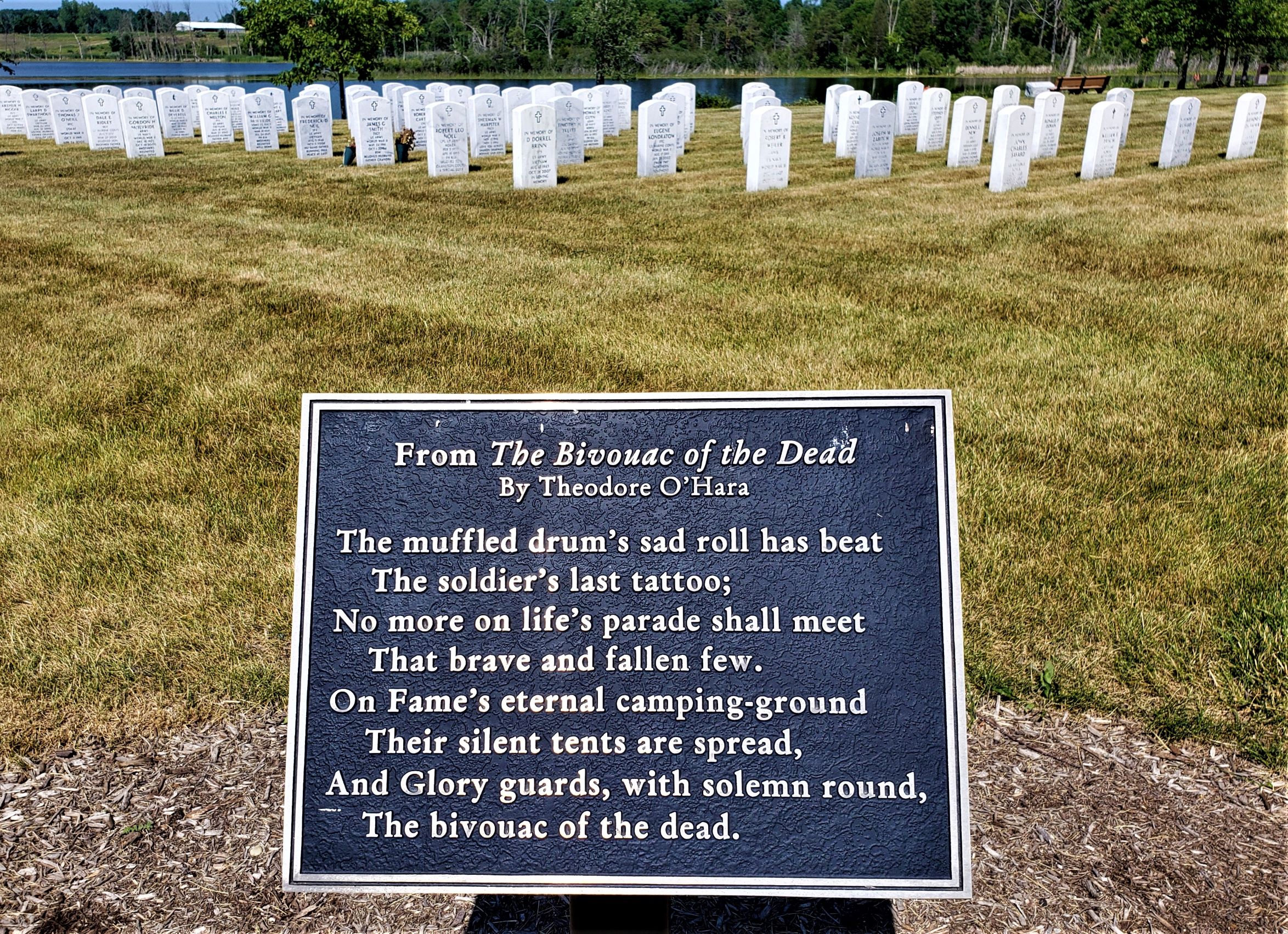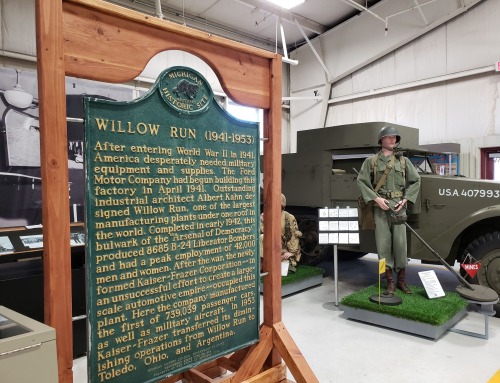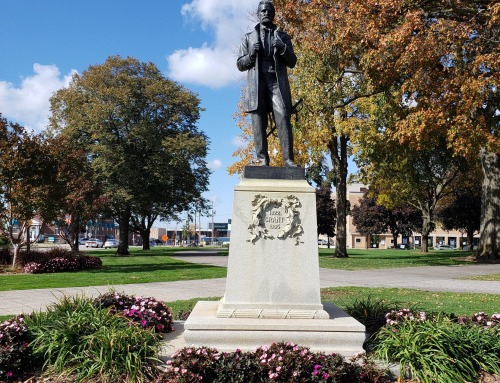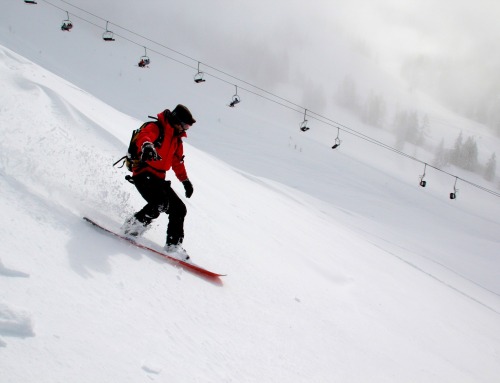Winters are not usually known for great battles, as historically, armies used the time to rest and regroup. That is not to say the cold and snowy weather hasn’t had a drastic effect on warfare. Who can deny the importance of Washington crossing the Delaware on December 25, 1776, when the ragged Continental Army defeated highly trained Hessian mercenaries at Trenton? The unlikely battle boosted the morale of the Americans and inspired many soldiers to re-enlist. Across the ocean, Russian winters proved disastrous for Napoleon and Hitler. Both leaders attempted winter invasions, failed horribly, and damaged their entire military campaigns. There have been few winter battles in Michigan, but during the American Civil War, a young soldier from our state made himself famous at the Battle of Fredericksburg in Virginia. Though his heroics have been questioned and denied, Robert Henry Hendershot’s actions dubbed him the “Drummer Boy of the Rappahannock” on December 11, 1862.
Robert Henry Hendershot was born sometime between 1847 and 1851 in either New York or Michigan. Records were not kept as well in those days. He was described as a slight-framed boy with light hair, hazel eyes and a ruddy complexion. He was well known for being a bit of a troublemaker, and also suffered from epileptic seizures. He was a frequent runaway, who barely attended school. While living with his widowed mother in Jackson, Michigan in 1861, he longed for the glory of battle. War fever was very prevalent in Jackson at the time and Robert began drilling with the local volunteer unit. When that unit marched to Fort Wayne, outside of Detroit, and became Company C of the 9th Michigan Infantry, Robert didn’t enlist officially, but followed the regiment to its encampment at West Point. He was likely serving as a servant to Captain Charles DeLand. The young man remained with Company C until March of 1862, then enlisted in Company B as a musician.
On July 13, 1862 while in Murfreesboro, Tennessee, Robert and his company were attacked by a Confederate cavalry brigade, led by Brigadier General Nathan Bedford Forrest. The entire Michigan regiment was captured, then paroled at Camp Chase in Ohio. All the men swore not to fight against the Confederacy until officially exchanged. Not long after that, Robert was discharged from the army on grounds of a disability. Robert claimed it was because he was wounded in the battle, but the official report cited his epileptic seizures.
In spite of the fact that he had not been exchanged yet and had been discharged, Robert enlisted in the 8th Michigan infantry that September, but used the alias Robert Henry Henderson. This was a common practice at the time, though many called it despicable. Robert became the aide of the recruiter, Lieutenant Michael Hogan, and kept that position for the next two months. While there, stuck in Detroit, it seemed unlikely that he would see action. A chaplain, George Taylor, part of the 8th Michigan Infantry, arrived from Ann Arbor and developed a liking for Robert. Taylor was able to have the young man placed under his care. The two traveled south, but at the depot in Washington, Robert had one of his seizures and fell in front of a train. Luckily, Taylor was there to pull him to safety. A few days later, another seizure struck Robert, this time while participating in a dress parade. Robert was compelled to tell Taylor about his condition, the discharge from the 9th Michigan, and re-enlisting under an assumed name. Taylor agreed to keep the secret, but Robert’s seizures continued. His regimental commander, Major Ralph Ely, had no choice but to order Robert off duty and apply for another medical discharge.
Robert was now free of his military duties, but he remained in the Union encampment. The war had taken the 9th Michigan to the banks of the Rappahannock River, on Stafford Heights, in December. Opposite the river lay Fredericksburg, a city that was midway between Washington City (now Washington DC) and Richmond, Virginia, the two capital cities of the armies. The Union was waiting on supplies and orders, which delayed their plans of crossing the river and attacking the town. Union engineers finally arrived and began constructing pontoon bridges so the infantry could march across. They worked under heavy fire from Confederate sharpshooters.
On December 11, the 7th Michigan infantry volunteered to cross the river in boats and chase the rebels from their position so the engineers could continue building. Robert had taken to wandering through the camp and banks of the river. Seeing what was about to happen and wanting to join in the action, he helped push the first boat off and tried to hop aboard. He slipped, and claims to have made the frigid voyage simply by clinging to the gunwale of the boat. Official records describe a drummer boy of 13 years old who volunteered to go across on the first boat, which adds substance to Robert’s stories. He later told Chaplain Taylor that he went into deserted houses with other soldiers and even set fire to a building. He also claimed to have found a Rebel soldier hiding in a cellar and took the man prisoner.
Reports of the young man who joined in the first instance of urban warfare in North America made the papers, though at first, the soldier was unnamed. At the end of December, when Robert had finally been discharged, he made his way to New York, then Baltimore, then Detroit. In those cities, he laid claim to the title, Drummer Boy of the Rappahannock.
Robert Henry Hendershot’s fame grew from there. In Detroit, he appeared at a local theater, where crowds listened and cheered for him as he performed drum solos. He then returned to Jackson. You would think that his hometown would give him a hero’s welcome, but they appeared to shrug off his tales, likely remembering his propensity for exaggerating and untrustworthiness.
News of the Drummer Boy of the Rappahannock spread through the north and drew the attention of famed newspaperman Horace Greely. The founder and editor of the New York Tribune brought Robert to the city and presented him with a silver drum. He and others, including retired general-in-chief Winfield Scott and PT Barnum, quickly made Robert into a Northern icon of wartime bravery. For eight weeks after Greely’s presentation, the drummer boy performed at Barnum’s museum and was also awarded a scholarship to the Poughkeepsie Business College in New York. Robert didn’t remain in school long, but did so, long enough to learn to sign his own name.
On April 1, 1864, Robert enlisted as a first-class boy aboard the USS Fort Jackson at Hampton Roads, Virginia. His tales of heroism continued, including being part of a shore party that destroyed a salt works near Fort Fisher. There was also a report that he had a seizure and fell overboard, but was saved by a fellow shipmate. His time in the Navy ended on June 26, 1864. Robert claims that he was discharged, but the ship’s official log reports him as a deserter.
The next few months, Robert went on a grand tour of England, then served as a page in the Treasury Department. He also claims to have undertaken dangerous missions as a spy under General Grant, operating behind enemy lines. By the time the war ended in April of 1865, Robert Henderson had collected a portfolio of impressive endorsements from a host of famed individuals. These included Generals George Meade, Ambrose Burnside, John A. Logan, John Parkhurst and even President Abraham Lincoln himself. The generals even recommended him for an appointment to West Point. Robert never attended the military academy, claiming he was denied admission because of his medical condition or his inability to pass the entrance exams. The academy’s records deny this claim, as there was no application for him on file.
Robert Hendershot returned to his former business school for a brief time. While there, he met and married a fellow student, Alice Blanchard. They had three children between 1868 and 1874, Cleveland, Annie and Honore May. In 1867, he worked with author William Sumner Dodge and together, they wrote a 200-page biography: Robert Henry Hendershot, or the Brave Drummer Boy of the Rappahannock. He and his family then moved to Omaha, Nebraska where he began working for the Union Pacific Railroad. In 1870, he applied for an appointment as a postal clerk on the Lake Shore and Michigan Southern Railroad, and received it. That job took the Hendershots to Chicago. Robert worked there until his retirement in 1885, living out of the limelight.
Once retired, Robert was free to travel. He took out his silver drum from Horace Greely and began touring the country with his son, who played the fife. They mainly performed at patriotic gatherings, including functions for the Grand Army of the Republic (GAR). The father-son duo made it all the way to Canada and the Kingdom of Hawaii, where they played for Queen Liliuokalani. She gifted him drumsticks carved from the spear of an ancient Hawaiian warrior.
By July of 1891, Robert Henry Hendershot was one of the best-known veteran drummer boys, and was invited to lead the Michigan Department in the GAR parade during the annual national encampment in Detroit that August. It was at this event that other veterans, one man in particular, began to loudly question Robert’s fame and honors. The most ardent of these was the 7th Michigan’s former drum major, William F. Dickerson, who pronounced that Robert was a fake and a liar, then asked the encampment organizers to remove him from the place of honor. Dickerson gathered others from his regiment and, though Robert did march at the head of Michigan veterans in the parade, the next day, Dickerson’s efforts came to fruition. Robert faced an inquiry about his story from the Battle of Fredericksburg, and other members of the 7th Michigan were questioned as well. By the end of the investigation, it was concluded that Robert’s claims were false and he was stripped of the title “Drummer Boy of the Rappahannock”. The title was awarded to John T. Spillaine, a policeman from Detroit and former drummer boy from the 7th Michigan. Spillaine accepted the title and wore the medal presented to him for the rest of his life. Robert’s other regiment, the Michigan 8th came down even harder, and found him guilty of fraud, imposition, constructed forgeries, and deserting his flag under fire.
Robert was not about to simply allow his name to be dragged through the mud. He appealed to local media with a narrative of his actions at Fredericksburg, reminding people of the fact that his heroism had been widely reported at the time it happened. To the individuals who claimed he deserted, he insisted he had been wounded and sent to a hospital in Washington City. Dickerson and the others sent in their rebuttals, and Dickerson accused Robert of being in a creek near the encampment at the time of the battle ‘feigning a fit’.
Robert had at least one ally to defend him in Reverend George Taylor. The older man recounted his side of the story and confirmed that he strongly believed Robert was the famed drummer boy. Dickerson countered again, and a drummer who had served with Robert, William Brewster, called Robert a camp follower, scoundrel and thief. The accusations raged for months. I can only imagine what the Twitter war would have been like if Social Media had been around at the time.
The controversy had still not been settled in 1892, when the GAR had their annual meeting in Washington City. The membership reaffirmed John Spillaine as the famed drummer boy, and Robert didn’t even bother to attend the meeting. He traveled from coast to coast, calling upon comrades from his first regiment, the 9th, to help him. This group passed a resolution supporting Robert. Next, he turned his attention to a regiment that had been against him and attended the annual reunion of the 8th. They reversed their earlier stance and passed a unanimous resolution to restore him and support his claim to the title.
By the time the national convention in 1893 rolled around, Robert Hendershot had won his fight. Soon after, he wrote a second biography: Camp Fire Entertainment: The True Story of RH Hendershot, Drummer Boy of the Rappahannock. He continued his career as a professional veteran drummer boy and in 1914, performed during a reunion of the Iron Brigade in Detroit.
The title of Drummer Boy of the Rappahannock wasn’t the only battle Robert had to fight in his retirement. In 1890, he applied for pension for invalid veterans. It was based on his service in the 9th Michigan, and the Pension Bureau scheduled a medical examination, but Robert failed to attend three times. The matter was dropped for two more decades, and Robert and his son toured the country. In 1912, he applied for a veteran’s old age pension, based on his service in the 8th and 9th Michigan Infantries. The Bureau could find no record of his service with the 8th, which made sense, as he used an assumed name. Robert brought up his naval service, but he was still listed as a deserter, and his application was rejected.
For the next ten years, Robert Hendershot gathered affidavits, hired lawyers, and exchanged letters with the Bureau, but failed to obtain his pension. In 1921, he appealed to Congress, stating that he was a bedridden invalid and suffering from Parkinson’s disease. By a special act, on December 23, 1924, Congress granted him an old-age pension. Robert felt he deserved an invalid’s pension, which was worth more money, but died before he could win that battle. On December 26, 1925, the Drummer Boy of the Rappahannock succumbed to pneumonia.
The jury is still out and we may never know the true story of all the tales told by Robert but it is a sure thing that he led a most intriguing life during and after the Civil War. The anniversary of the Battle of Fredericksburg is in December and the weather has not yet turned bitter cold in our state of Michigan but I for one choose to believe at least some of the tales of this interesting veteran who made a name for himself whether it be good or bad.







Leave A Comment
You must be logged in to post a comment.